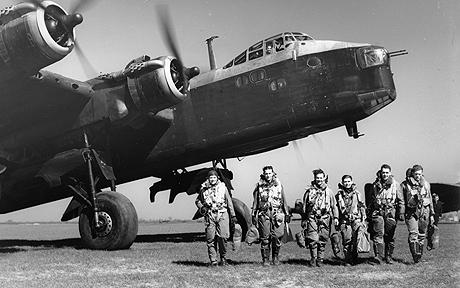The 7 Sqdn left from Oakington at 1941-07-15 at 23:00. Loc or duty Hannover
He flew with a Short Stirling (type I, serial N6033, code MG-).
Campaign report of the USAAF:
No report
Campaign report of the RAF:
July
After repeated attempts, the Prinz Eugen was finally hit during a raid by 52 Wellingtons on Brest during the first night of the month. Two bombers were hit, one crashing next to the warship. One bomb, possibly from this aircraft, hit the Prinz Eugen and exploded causing the loss of over 60 sailors. For his outstanding leadership during a daylight low-level raid on Bremen by 12 Blenheims on the 4th, the leader, Wing Commander Hughie Edwards of No 105 Squadron, was awarded the Victoria Cross - the first Australian to receive the honour. Three days later 109 Hampdens and Wellingtons made yet another attempt to dispose of German capital ships berthed at Brest. Again, they were foiled by a thick smoke-screen laid down to cover the vessels.
A new directive was issued to the Command during the month. Absent was any mention of oil as it was realised that Bomber Command did not have the accuracy to pursue the destruction of these targets and a resumption of attacks against Germany was called for as much of the Luftwaffe's attention was pointed to the East and in particular, Russia. The directive went on to say: "'..there are many sighs that our recent attacks on industrial towns are having a great effect on the morale of the civilian population."' It continued: "I am to request that you will direct the main effort of the bomber force…towards dislocating the German transportation system and to destroying the morale of the civilian population as a whole and of the industrial workers in particular." Specific targets were listed in the document, many of them in and around the huge industrial centre of the Ruhr. Support to the Battle of the Atlantic was also reduced, with occasional visits to occupied ports and U-boat bases being required.
There was little change in the number of aircraft available for operations to Bomber Command. The formation of new squadrons was offset by the continuing need to provide aircraft for operations in other theatres such as the Middle and Far East, and new aircraft such as the Manchester and Halifax were suffering a number of technical problems which limited their availability.
This new directive coincided with a restructuring of German night defences - especially the tactics of the night-fighters.
Almost immediately Bomber Command implemented the new plan. During the night of 7th/8th July, 275 aircraft were involved in raids on Cologne, Osnabrück, Munster and Monchengladbach, with Cologne suffering a particularly sharp attack in good bombing conditions. Sgt JA Ward, a New Zealander with No 75 (New Zealand) Squadron was awarded the Victoria Cross for his bravery in attempting to fight a fire on the starboard wing of his Wellington which had been hit by a defending fighter during the Munster raid. Upwards of 75 aircraft were ordered against individual targets in night operations, and on many occasions, more than one target was attacked in a night, although the damage caused by these raids was often negligible. The attacks against the Scharnhorst resumed on the 23rd after she had been moved to La Pallice some 200 south of Brest in preparation for her next Atlantic voyage. The following day, 15 Halifaxes were despatched without escort to La Pallice and met with fierce opposition. Five aircraft were lost, and all of the others were damaged in some way. Five direct hits were recorded on the battleship, but three armour-piercing bombs passed straight through the Scharnhorst without exploding, but causing a large amount of water to flood some areas. The ship was later moved back to Brest where it could be afforded better protection. Meanwhile at Brest, 79 Wellingtons, also operating without fighter escort, as well as 18 Hampdens and 3 Fortresses with an escort attacked the port and 6 hits were claimed on the Gneisenau. 10 Wellingtons and 2 Hampdens were lost to enemy fighters which had been drawn up by the escorted bombers. This was also the first operational use of the new American-built Fortress.
With thanks to the RAF and USAAF.net!
This record can also be found on the maps of Back to Normandy with Google coordinates. You can find the maps by clicking on this link on this location.
There are several possibilities to investigate the flight records on Back to Normandy. All the flights are plotted on maps, sorted "day by day", "by squadron", "by type aircraft", "by year or month", "by location" and much more! Don't miss this!!!
If you have any information that you want to share, please add your comment at the bottom of this record. Or send your information to [email protected]. This information will be added to the record.
Your photos and your information are very welcome! The young do care and with your help we keep up the good work.



